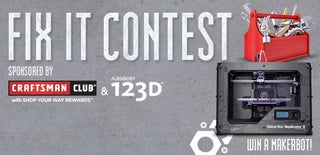Introduction: Fix Psychotic Grand Am Signal Clicking
I have a 2001 Pontiac Grand Am. About 5 years ago while driving down the road, the clicking noise, associated with the signal light and hazards, went psychotic. I panicked because I thought the lights were also activated. Nope, just the awful noise and about 2x faster than normal. My nerves didn't last long and I took the car to the dealership. About an hour later, they came out and said that it was fixed and the part was recalled. I didn't pay a penny! Whoo hoo!
About a year ago, the clicking returned. Although annoying, it wasn't nearly as bad but I called the dealership again. They said that the sound was NOT the same as before (they must be really good to know this over the phone) and that the fix would cost over $300. No, thanks. I'll pass and deal with the noise. (PS. Don't do that with every noise.) Soon after, I wasn't having any problems.
Fast forward to about a month ago and it went nuts again. I decided that I was going to tackle the job of fixing it. Could I afford to pay the dealership? Probably. Two reasons why I won't though. #1 - I don't believe that it isn't the same part. #2 - I am female! Hear me roar! I told myself that I could do it so I set out researching the problem.
In my FIRST instructable, I will show you what to do to rule out the easy fix. DO NOT be intimidated. Yes, I am technically and mechanically inclined but I would not have attempted this if I thought there was any way I could screw it up. I also watched the following videos at least three times each and used auto websites through the library to get diagrams. The diagrams are actually what gave me the idea to write this instructable. They suck. If you don't already know what you're looking at, they are not much help. If you do know what the diagrams cover, you probably don't even need them.
Thank you SO much to these guys who helped me get through this. I just wanted to share more details and simplified instructions for those who want to try to fix their own car. This process should work with multiple years of Grand Am productions. If anyone knows exactly, please let me know.
http://www.youtube.com/watch?v=e5g-1UkGFJA
http://www.youtube.com/watch?v=NPTkLD2JR9Q
Step 1: Materials and Tools
In addition to what is in the photo, I used a flat-head screwdriver in a step towards the end.
Ratchet Set - $12. I needed it anyway. Time to get rid of my old, chewed up set. I hope the puppy enjoyed that...
8mm Socket - Came with my set.
T25 and T10 - Also in the set. SCORE!
Cotton swabs
Dielectric grease.
Step 2: Prep and Removing Steering Wheel Cover.
My apologies to any mechanics who know the actual names of these parts. Frankly, if you are an actual mechanic I don’t know why you’d be reading this. That's one reason why you do what you do. I'm going to purposely use layman and sometimes made up terms. Either way, you'll know what I'm talking about. I will also probably over-use emoticons, commas and ellipsis.
I ALWAYS engage the parking brake no matter what I’m doing. It doesn’t hurt anything and it gets you in the habit of doing it since it’s required for changing tires or putting the car on ramps for an oil change. Until now, these things are about all I’ve done myself.
Remove the NEGATIVE side of your car battery. This is a very important step. You will see later that you are working very close to some electronics and I’m sure you don’t want to be eating an airbag. (Snack before starting this job.)
Step 3: Remove Top Cover.
If you have plump legs like I do, get in the car first and then put the steering wheel all the way down.
You will need to place one or two fingers under the top cover. Hmmm...OH! Back to the instructions. Use the open space above the turn signal and wiper levers. I had to pull up with a good amount of force. Don't be surprised if you jump because it pops off unexpectedly.
I've spent the last 8 years delicately accessorizing my car with the lovely dirt you see. Don't disregard it...relish it.
Step 4: Torx Removal.
Now that you can see the guts of your steering wheel, remove this one Torx thingymabob using the T25 bit.
Step 5: Unclip Wiring Groups.
Next, there are three different electrical sets of wires. Each one has a different kind of clip and are located in different areas. You shouldn't worry about mixing them up. There is one on top, one on the right side and the one on the left should be last because you might need to pull the section up a little to get to it. When I had all three unplugged, it still wouldn't pull up and out. I ended up finding a plastic piece on the side that I pulled forward a little and that released it. It may just be a fluke with mine.
Step 6: Removing Signal Side Torx.
If you are correct-handed AKA right-handed, you will need to turn this assembly around so that the turn signal lever is on your right side. Lefties, sorry but figure that one out on your own. Whatever works best.
You will find four more Torx thingymajigs. These are the ones in which you need the T10 bit. You should be able to remove them with no special extensions. If you have a magnetic tray, it would come in handy for small parts like these. I just used the grooves in the passenger seat to keep track of everything.
You do not need to and SHOULD NOT take apart this whole assembly. The very nice people I learned from have stated that there are springs in the other side. Just be very careful not to pull apart the right side too far. It will snap in two.
Step 7: Clean the Probes!
Next, you will need to look for what I will refer to as the copper probes. Normally, these would not fit my description of "probes" but that word makes me chuckle. "She said you offered to show her your Probe!" As you can see in the photo, the lube on my probes was quite dirty. Probably from all the action it's gotten in the last 8 years.
At this point, take your cotton tipped sticks and carefully clean all that nastiness off of both the probes. Try not to leave cotton threads in or around it. When it is cleaned, the probes should sparkle and look new. All better!
I couldn't get a really good pic of the metal shavings I found on the cotton swabs but there were two good sized ones. These and the dirt are probably the culprits of my psychotic clicking noise.
Step 8: Relube the Probes.
Squeeze a little bit of the dielectric grease (you so confidently bought from Big Hoss at the auto store) on a CLEAN cotton swab. Spread it around on both probes to insure ultimate lube coverage. When you think you have enough to help prevent probe friction, put the small Torx thingymabobbers back.
Step 9: Assembling the Assembly :P
At this point, you need to place the assembly back on top of the steering wheel. Line it up but DO NOT FORCE IT. There are 1-2 pins that need to be pushed in. They contact the back disk to operate the horn. If you disregard this, you will damage one or more parts. This is also where you get close to the airbag doowappies. I hope you unhooked the battery! (((I am now told by a lovely commenter that the airbags could still engage. Sooo, be very careful when working around the disks!)))
This is a good time to snap the left wiring group back to the assembly.
Use a flat-head screwdriver or something similar to push the pins back out of the way. You need to be pushing the assembly down in to place at the same time. It was kinda tricky. You might wrap painters or duct tape on the end of the screwdriver to keep it from slipping off of the pins. Again, I had to jimmy the little plastic piece and the assembly should drop right back in where it goes.
Step 10: Finish Up With Reassembly.
Clip the two other wiring groups back in to the assembly and secure the assembly with the T25 Torx thingy. At this point, I hooked the battery back up and checked to see if the signal lights and horn worked. Success so far! Some of the videos said to check the turn signal cancel by turning the wheel but unless the car is in the air or you are on slick ground, you can't...at least I couldn't on the cement drive.
Place the top cover back on the steering wheel by hooking the back first and then pressing down on the front to snap it back on.
TA-DA!
Now...for reality. When I tried the signal lights to make sure they worked, the clicking went psycho. "DAMN IT ALL TO HELL!" So I thought, well, I took the plunge and I didn't break anything so I still saw it as a success and it ruled out that as a problem...
BUT after a few times of using the signal lights on the road, it no longer clicks sporadically. Why do I think it happened like this? Well, I think the universe finally decided to give me a break. I also think that the probes just needed to get used to the new lube and they are happy now.
I hope this helps SOMEONE and at some point it will be outdated but I thought it might come in handy to have detailed photos and it was a good subject to use for my first INSTRUCTABLE!
What is next? Replacing the inside and outside door handles I broke on another car. Guess I don't know my own strength.
If you see something I missed, please let me know. I know there will be that one...or two who won't be satisfied with my instructions but if you are tackling this project and have true questions, "goat head" and ask me! Thanks for stopping by and being patient!

Participated in the
Fix It Contest

Participated in the
Cars & Motorcycles Contest











